
Morrilton is a city in Conway County, Arkansas, United States, less than 50 miles (80 km) northwest of Little Rock. The city is the county seat of Conway County. The population was 6,992 at the 2020 United States census.
Harding University is a Christian private university with its main campus in Searcy, Arkansas. It is the largest private university in Arkansas. Established in 1924, the institution offers undergraduate, graduate, and pre-professional programs. The university also includes the Harding School of Theology, located in Memphis, Tennessee, which was formerly known as Harding Graduate School of Religion. Harding is one of several institutions of higher learning associated with the Churches of Christ.

Arkansas Tech University (ATU) is a public university in Russellville, Arkansas, United States. The university offers programs at both baccalaureate and graduate levels in a range of fields. The Arkansas Tech University–Ozark Campus, a two-year satellite campus in the town of Ozark, primarily focuses on associate and certificate education.
Solgohachiasaw-gə-HA-chee is an unincorporated community in Conway County, Arkansas, United States, about 10 miles (16 km) north of Morrilton on Arkansas Highway 9 and Arkansas Highway 287. The ZIP Code for Solgohachia is 72156. The name is from the Choctaw word Sok-ko-huch-cha, meaning "muscadine river".

The Arkansas Activities Association (AAA) is the primary sanctioning body for high school sports in state of Arkansas. AAA is a member association of the National Federation of State High School Associations (NFSHSA). Every public secondary school in Arkansas is a de jure member of the AAA, and most private schools, save for a few schools in the delta that belong to the Mississippi Private Schools Association and 22 Christian schools who belong to the Heartland Christian Athletic Association, are included in membership.

Highway 9 is a designation for two north–south state highways in Arkansas. A southern segment of 51.44 miles (82.78 km) begins at U.S. Route 79 at Eagle Mills and heads north to U.S. Route 67 in Malvern before terminating. The northern segment of 174.17 miles (280.30 km) runs from AR 5 to U.S. Route 63 in Mammoth Spring. The route was created during the 1926 Arkansas state highway numbering, and has seen only minor extensions and realignments since. Pieces of both routes are designated as Arkansas Heritage Trails for use during the Civil War and the Trail of Tears.

Saint Anthony's Hospital is a historic hospital building at 202 East Green Street in Morrilton, Arkansas. Built in 1935 to a design by A. N. McAninch, it is an Art Deco building, finished in brick and stone. It served as the local hospital until 1970, and is now a senior living facility. It is Morrilton's best example of Art Deco architecture. It has two splayed wings, with a central projecting entry pavilion.

Highway 95 is a designation for a north–south state highway in north central Arkansas. The route runs 49.40 miles (79.50 km) runs north from US Highway 64 and Highway 113 in Morrilton north to Highway 330.

Charles L. Thompson and associates is an architectural group that was established in Arkansas since the late 1800s. It is now known as Cromwell Architects Engineers, Inc.. This article is about Thompson and associates' work as part of one architectural group, and its predecessor and descendant firms, including under names Charles L. Thompson,Thompson & Harding,Sanders & Ginocchio, and Thompson, Sanders and Ginocchio.
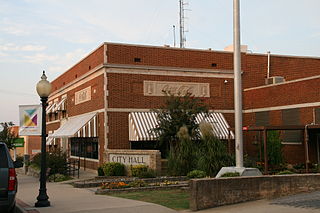
The Coca-Cola Building is a historic commercial building at 211 North Moose Street in Morrilton, Arkansas. It is a two-story masonry structure, built out of red brick with limestone trim. It has relatively clean Colonial Revival lines, with stone string courses between floors, a stone cornice below a parapet, and stone panels carved with the stylized Coca-Cola logo. It was built in 1929 to a design by the noted Arkansas architectural firm Thompson, Sanders & Ginocchio.
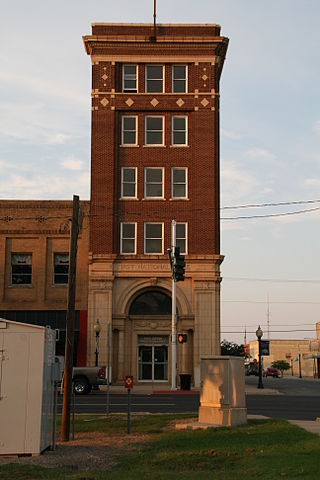
The First National Bank of Morrilton is a historic commercial building at Broadway and Moose Streets in Morrilton, Arkansas. It is a narrow five-story masonry building, occupying a prominent location at the city's main downtown intersection. It was built in 1925 to a design by architect Charles L. Thompson, and has Classical Revival and Bungalow/Craftsman features. The short Broadway Street facade features a recessed entrance with Classical features, while the upper floors are relatively unadorned red brick, with Craftsman motifs in tile around the top floor windows.

The Conway County Courthouse is located at 117 S. Moose Street in downtown Morrilton, Arkansas, the county seat of Conway County. It is a 2+1⁄2-story masonry building, built out of red brick with trim of white concrete and white terra cotta. Dominating the main facade are five slightly recessed bays, articulated by four two-story engaged round columns, and flanked by square pilasters. The outer bays of the facade are each flanked by brick pilasters with cast terra cotta bases and capitals. The courthouse was built in 1929 to a design by Arkansas architect Frank W. Gibb.
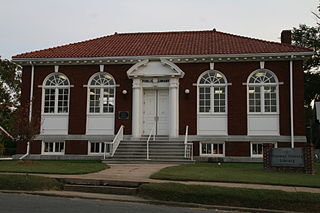
The Conway County Library is the public library system of Conway County, Arkansas. The main library is located at 101 West Church Street in downtown Morrilton, Arkansas, the county seat. The library is located in a Classical Revival brick building designed by Thomas Harding and funded in part by a grant from Andrew Carnegie. In 1916 the Pathfinder Club of Morrilton applied for the grant. A lot was purchased, and Morrilton Mayor J. A. Frisby, Night Rainwater, and W. M. Riddick worked with a committee to construct the new library. The construction cost was $7,500, leaving $2,500 to purchase coal and furniture for the building. The building was completed in October 1916 and still serves as the Conway County Library. The building was listed on the National Register of Historic Places in 1978. The library organization began as a private collection in 1894, and was housed in private residences and vacant commercial buildings prior to the construction of this building.

The Cox House is a historic house on Bridge Street in Morrilton, Arkansas. It is a small but architecturally eclectic single-story wood-frame house, with a gable roof and weatherboard siding. It has a projecting gabled porch, with bargeboard on the gable rake edges, brackets on the eaves, low-pitch gabled cornices over the front windows, and a broad two-leaf entrance with sidelight windows. It was built in 1875 by Hance Wesley Burrow, a farmer and veteran of the American Civil War.
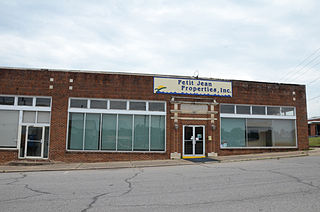
The Earl Building is a historic commercial building at 201 North St. Joseph Street in Morrilton, Arkansas. It is a single-story frame structure, with brick walls and a flat roof. It is roughly L-shaped, with one wing originally serving as an automotive showroom and the other as a service and supply area. It was built in 1926 and enlarged a few years later, and is a well-preserved example of a 1920s automotive dealership building.
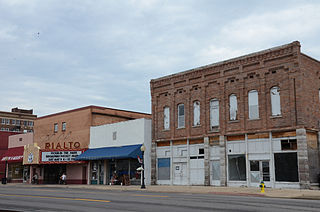
The Morrilton Commercial Historic District encompasses the historic central business district of Morrilton, Arkansas. The L-shaped district includes two blocks of East Railroad and East Broadway, between Division and Chestnut Streets, and three blocks of Division and Chestnut Streets, between Broadway and Vine. This area was mostly developed between 1880 and the 1920s, and was heavily influenced by the railroad, which passes between Broadway and Railroad. Prominent buildings in the district include the Morrilton Post Office, Morrilton Railroad Station, First National Bank of Morrilton, and the Coca-Cola Building.
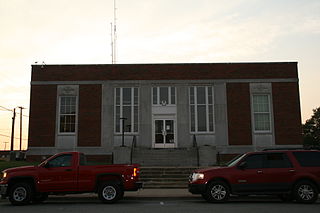
The former Morrilton Post Office is a historic post office building at 117 North Division Street in downtown Morrilton, Arkansas. It is a single-story masonry structure, built of brick and limestone in a simplified Art Deco style. Its facade is divided into five bays, the outer two separated by brick piers from the inner three. The inner three are articulated by limestone pilasters, and feature large multipane windows and the main entrance. The interior features a mural entitled Men at Rest by Richard Sargent, painted in the 1930s as part of a federal works project.

The former Morrilton station is located on Railroad Avenue, between Division and Moose Streets, in downtown Morrilton, Arkansas. It is a single-story brick building, with a tile roof and Mediterranean styling typical of the stations of the Missouri Pacific Railroad. The broadly overhanging roof is supported by large brackets, with a telegrapher's bay projecting on the track side. Built about 1907, it is an important reminder of the railroad's importance in the city's history. It now houses a local history museum.
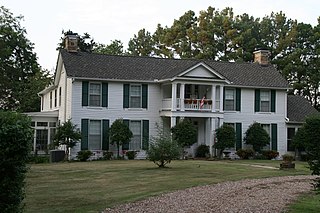
The Moose House is a historic house at 711 Green Street in Morrilton, Arkansas. It is a 2½-story wood-frame structure with a gabled roof and weatherboard siding. A two-story gabled porch projects from the center bay, supported by paired square columns. The house was built around 1832 in Lewisburg on the Arkansas river and known as the Markham Tavern. It was moved to its current location after the Civil War by James Miles Moose, one of the two founders of Morrilton. The area where this house was built was farmland until the 1880s, when the railroad arrived in the area, prompting the two men to lobby for a railroad station, around which the town grew.

The West Church Street Historic District encompasses a collection of the finest late-19th and early-20th century homes in Morrilton, Arkansas. The district extends along West Church Street between South Morrill and South Cherokee Streets, and includes 23 primary buildings. All are houses, and include buildings from the earliest days of the city through the 1920s. The majority of the district's houses were built between 1926 and 1942, and are mainly Craftsman in style.



















